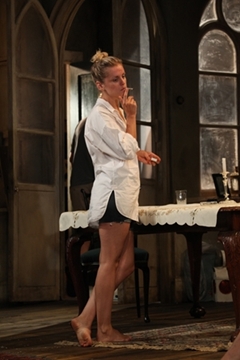Based on Daphne du Maurier’s short story, The Birds (1952), which inspired Alfred Hitchcock’s 1963 film of the same title, Conor McPherson’s new play is set in an isolated lakeside house, sometime, somewhere in the present. Relative strangers Nat (Hinds) and Diane (Cusack) have taken refuge in the abandoned dwelling, seeking sanctuary from the winged beasts that have been killing all around them. The corpse of a recent victim must first be removed from upstairs before they can settle in, but even then there is no chance of getting comfortable. The electricity is down, supplies are low, and the gulls rise, ritualistically, with the tides. Soon, fear of the outside world breeds paranoia of internal relations, and the arrival of young Julia (Gough), complicates what was presumed to be a battle with nature.
While du Maurier’s Cornish tale of invasion resonates with a post second World War climate, and Hitchcock’s Californian adaptation is replete with psychosexual anxiety, McPherson’s version seems to be more interested in a writer’s role in making sense of a chaotic world. Given the preoccupations of plays such as The Weir and Shining City, this is perhaps no surprise. While Nat is the protagonist of the short story, Diane is very much the focus of this work. It is she who tries to manage the crisis, and it is she who endeavours to make sense of it all in her journal entries.
While Diane writes, a voiceover reveals her most intimate thoughts. Initially, these reflections revolve around the daughter with whom she has fallen out, and the birds that swoop overhead. Eventually she turns her mind to the people with whom she now lives. Throughout the play, it emerges that she and her accidental family have devoted so much attention to erecting barriers between people and worlds (private and public, imagined and real) that the increasingly intensified inner sphere in which they live is set to implode. Nat and Julia turn to each other for comfort, and Diane turns to her page.
 Diane suddenly begins to contemplate murder when she learns of Julia’s surprise pregnancy, reasoning there is a difference between controlling something creatively with words, and mastering it with brute force in real life. “Once you have killed it calls you again,” she writes, until you can no longer resist “the giddy enthusiasm of murder”. And even though Diane challenges Julia’s literal interpretation of her journal entries, she too comes to actualize her creative desire by barring up the windows and doors when Julie leaves to find Nat.
Diane suddenly begins to contemplate murder when she learns of Julia’s surprise pregnancy, reasoning there is a difference between controlling something creatively with words, and mastering it with brute force in real life. “Once you have killed it calls you again,” she writes, until you can no longer resist “the giddy enthusiasm of murder”. And even though Diane challenges Julia’s literal interpretation of her journal entries, she too comes to actualize her creative desire by barring up the windows and doors when Julie leaves to find Nat.
Rae Smith’s design is realistic and detailed, although there is so much to see in the living space that it is all too easy to forget about the birds. On one occasion, we can see them pelt against the grimy windows, but more often than not we are reliant upon a rumbling, reverberating soundscape to remind us.
While the performances certainly warm up in the second half, often it feels as if Cusack and Hinds struggle to take ownership of McPherson’s language. It is hard to say a line such as the one Diane delivers to Julia - “Everyone in the world is dead. I’ve enough to worry about” - while setting the kitchen table, and still be taken seriously. More troublesome, however, is that the script feels unnecessarily stretched out, and there is little richness in the dialogue until the very end, when Diane pauses to consider God and the universe. But even these grand sentiments feel a bit insincere.
Moreover, the first half feels like an endless assembly of short, patchy scenes. When we are led to believe that the birds are still the focus of the action, rather than the internal relationships, or indeed the artist’s role, this is bearable; but when the evocative threat of the birds recedes from focus, the dialogue struggles to keep us engaged with the performance. This absence of tension or texture is notable in much of the delivery too, which is often loose and jittery, and the undisciplined Irish idiom struggles to draw us into such an unlikely fiction.
When a small flock of birds shoot across the stage at the end of the performance, they elicit more coos than ahs. The effect is cute rather than terrifying, but after spending over two and-a-half hours in the theatre threatened with man-eating gulls, you’re bound to feel a bit ruffled when all you get is a few homing pigeons. Still, this closing gesture manages to encapsulate a core difficulty with a play that hovers uneasily between a psychological study and an altogether more banal domestic drama.
See www.dublintheatrefestival.com
Fintan Walsh is a post-doctoral Research Fellow at Trinity College Dublin.